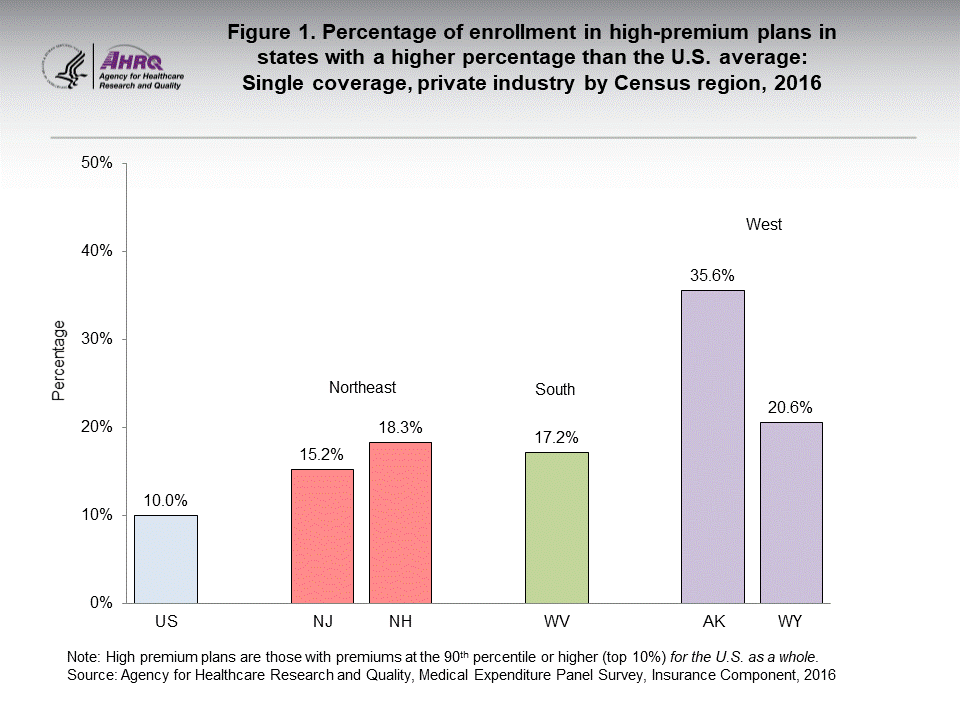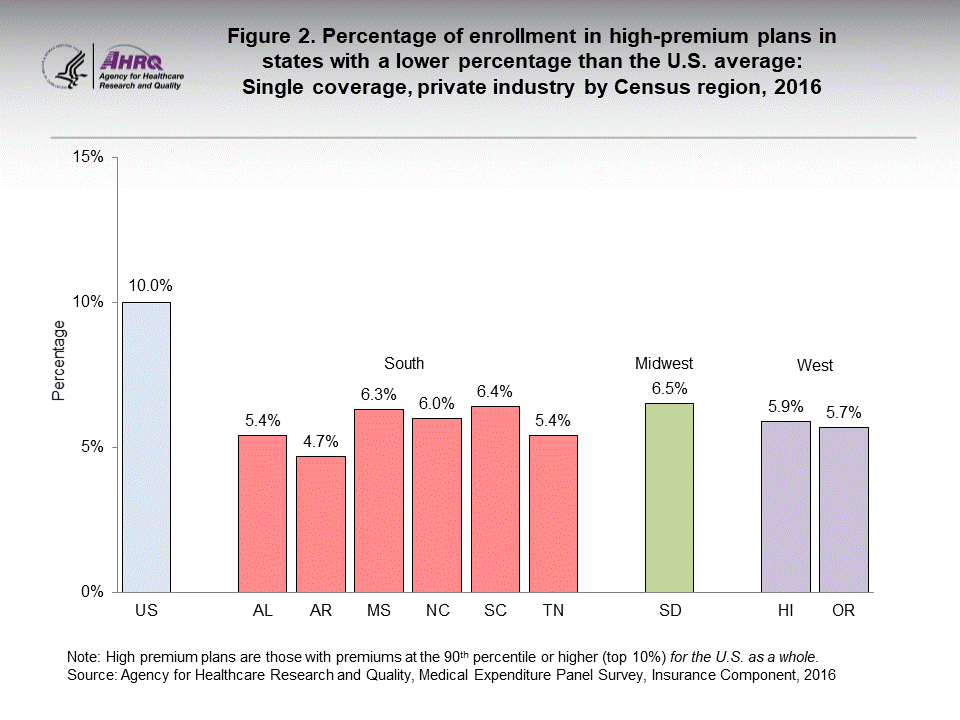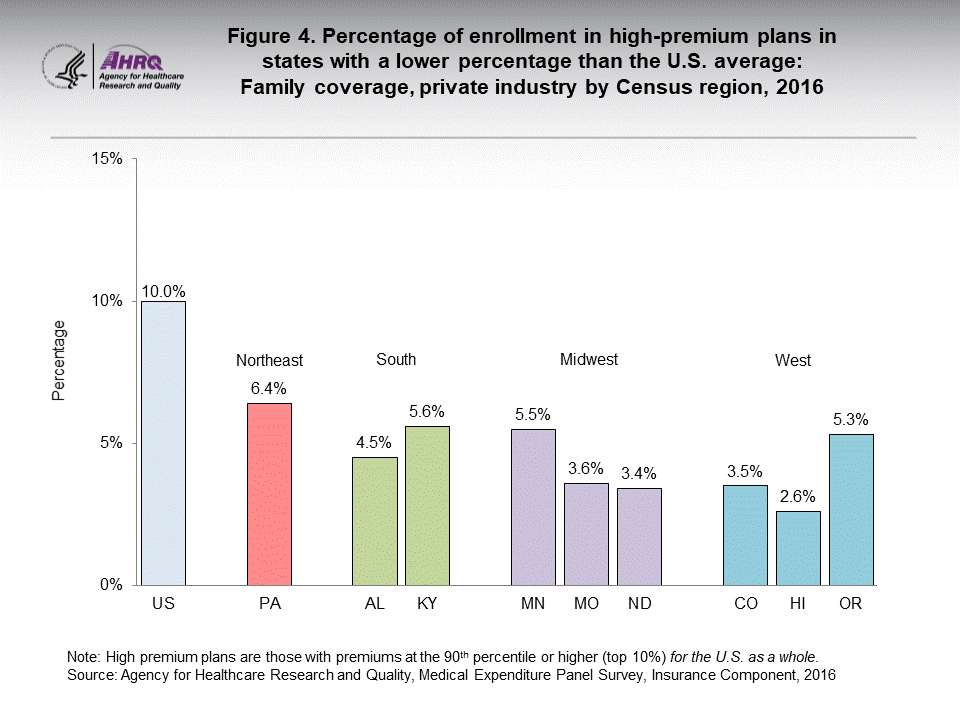Skip to main content
|
|||||||||||||||||||||||||||||
|
|
|||||||||||||||||||||||||||||
STATISTICAL BRIEF #519:
|
|||||||||||||||||||||||||||||
| December 2018 | |||||||||||||||||||||||||||||
|
Philip F. Cooper, PhD |
|||||||||||||||||||||||||||||
Highlights
|
|||||||||||||||||||||||||||||
IntroductionThis Statistical Brief reports estimates by state of the percentage of private-sector employees enrolled in employer-sponsored health insurance plans with high premiums, defined as those with annual premiums that were greater than or equal to the 90th percentile for single-coverage enrollees ($8,500) or family coverage enrollees ($24,000) in 2016. That is, of all enrollees across the U.S. within each coverage type, 10 percent had premiums at or above these amounts. These estimates were obtained using data from the 2016 Medical Expenditure Panel Survey-Insurance Component (MEPS-IC).Estimates are reported by state grouped by Census region (Northeast, Midwest, South, and West) and represent the percentages of enrollees in single and family coverage that have premiums at the national 90th percentile amount or higher. It should be noted that factors other than state of residence can affect premiums. Other factors include benefit packages that are more or less generous (through the absence or presence of deductibles and co-pays, for example), employer characteristics (such as firm size and industry), and demographic factors (such as age and health of enrollees). All estimates of the percentages of enrollees with high premiums that are discussed in the text are significantly different from 10 percent at the 0.05 level unless otherwise noted. |
|||||||||||||||||||||||||||||
FindingsFigure 1 shows all states in 2016 where the percentage of enrollees in high-premium single-coverage plans ($8,500 or more) exceeded 10 percent. Of the five states shown, two—New Jersey (15.2 percent) and New Hampshire (18.3 percent)—were located in the Northeast. The remaining three states were located in the South (West Virginia, 17.2 percent) and West (Alaska, 35.6 percent and Wyoming, 20.6 percent). Figure 2 shows all states where the percentage of enrollees in high-premium single-coverage plans was under 10 percent. The percentages ranged from 6.5 percent in South Dakota to 4.7 percent in Arkansas. Of the nine states listed, none were in the Northeast. In addition to Arkansas, five states were in the South (Alabama, 5.4 percent; Mississippi, 6.3 percent; North Carolina, 6.0 percent; South Carolina, 6.4 percent; and Tennessee, 5.4 percent). One state, South Dakota, was located in the Midwest. Two states were located in the West (Hawaii, 5.9 percent and Oregon, 5.7 percent). Figure 3 shows the six states where more than 10 percent of private-sector family enrollees were in high-premium plans ($24,000 or more). Three states were located in the Northeast (New Hampshire, 22.2 percent; New Jersey, 14.9 percent; and New York, 15.9 percent). One was located in the South (the District of Columbia, 16.0 percent) and two states were located in the West (Alaska, 36.0 percent; and Wyoming, 20.2 percent). Figure 4 shows the states where the percentage of private-sector family enrollees with high premiums was under 10 percent. One was located in the Northeast (Pennsylvania, 6.4 percent). Two states were located in the South (Alabama, 4.5 percent; and Kentucky, 5.6 percent). Three states were located in the Midwest (Minnesota, 5.5 percent; Missouri, 3.6 percent; and North Dakota, 3.4 percent) and three states were located in the West (Colorado, 3.5 percent; Hawaii, 2.6 percent; and Oregon, 5.3 percent). |
|||||||||||||||||||||||||||||
Data SourceThis Statistical Brief summarizes data from the 2016 MEPS-IC. The data are available on the MEPS Web site at https://meps.ahrq.gov/mepsweb/survey_comp/Insurance.jsp or have been produced using special computation runs on the confidential MEPS-IC data available at the U.S. Census Bureau. |
|||||||||||||||||||||||||||||
DefinitionsHealth insurance planAn insurance contract that provides hospital and/or physician coverage to an employee for an agreed-upon fee (premium) for a defined benefit period. Premium Agreed-upon fee paid for coverage of medical benefits for a defined benefit period, usually a calendar year. Premiums can vary based on a variety of factors, such as services covered, amounts of deductibles and co-pays, location of firm, and demographics of the workforce. Single coverage Health insurance that covers the employee only. Family coverage Health insurance that covers the employee and the employee's family. If a plan offered more than one pricing level for family coverage, information for a family of four was reported. State postal abbreviations Alabama, AL Alaska, AK Arizona, AZ Arkansas, AR California, CA Colorado, CO Connecticut, CT Delaware, DE Florida, FL Georgia, GA Hawaii, HI Idaho, ID Illinois, IL Indiana, IN Iowa, IA Kansas, KS Kentucky, KY Louisiana, LA Maine, ME Maryland, MD Massachusetts, MA Michigan, MI Minnesota, MN Mississippi, MS Missouri, MO Montana, MT Nebraska, NE Nevada, NV New Hampshire, NH New Jersey, NJ New Mexico, NM New York, NY North Carolina, NC North Dakota, ND Ohio, OH Oklahoma, OK Oregon, OR Pennsylvania, PA Rhode Island, RI South Carolina, SC South Dakota, SD Tennessee, TN Texas, TX Utah, UT Vermont, VT Virginia, VA Washington, WA West Virginia, WV Wisconsin, WI Wyoming, WY Census regions The U.S. Department of Commerce, Bureau of the Census, groups states into four regions and nine divisions: Northeast Region New England Division: Connecticut, Maine, Massachusetts, New Hampshire, Rhode Island, and Vermont Middle Atlantic Division: New Jersey, New York, and Pennsylvania Midwest Region East North Central Division: Illinois, Indiana, Michigan, Ohio, and Wisconsin West North Central Division: Iowa, Kansas, Minnesota, Missouri, Nebraska, North Dakota, and South Dakota South Region South Atlantic Division: Delaware, District of Columbia, Florida, Georgia, Maryland, North Carolina, South Carolina, Virginia, and West Virginia East South Central Division: Alabama, Kentucky, Mississippi, and Tennessee West South Central Division: Arkansas, Louisiana, Oklahoma, and Texas West Region Mountain Division: Arizona, Colorado, Idaho, Montana, Nevada, New Mexico, Utah, and Wyoming Pacific Division: Alaska, California, Hawaii, Oregon, and Washington | |||||||||||||||||||||||||||||
About MEPS-ICMEPS-IC is a survey of business establishments and governments that collects information on employer-sponsored health insurance, such as whether insurance is offered, enrollments, types of plans, and premiums. The survey is conducted annually by the U.S. Census Bureau under the sponsorship of the Agency for Healthcare Research and Quality. A total sample of approximately 42,000 private-sector establishments was selected for the 2016 survey, with 5.5 percent of the sample determined to be out-of-scope during the data collection process. The response rate for the private sector was 67.6 percent of the remaining in-scope sample units.For more information on this survey, see MEPS Methodology Reports 6, 8, 10, 14, 17, 18, 27, 28, 30, and 31 on the MEPS Web site at https://meps.ahrq.gov/mepsweb/data_stats/Pub_ProdLookup_Results.jsp? ProductType=Methodology%20Report&Comp=Insurance and Insurance Component Survey Basics at https://meps.ahrq.gov/mepsweb/survey_comp/Insurance.jsp. |
|||||||||||||||||||||||||||||
Suggested CitationCooper, P.F. Enrollment in High-Premium Employer-Sponsored Health Insurance by State: Private Industry, 2016. Statistical Brief #519. December 2018. Agency for Healthcare Research and Quality, Rockville, MD. https://meps.ahrq.gov/data_files/publications/st519/stat519.shtml |
|||||||||||||||||||||||||||||
|
AHRQ welcomes questions and comments from readers of this publication who are interested in obtaining more information about access, cost, use, financing, and quality of health care in the United States. We also invite you to tell us how you are using this Statistical Brief and other MEPS data and tools and to share suggestions on how MEPS products might be enhanced to further meet your needs. Please email us at MEPSProjectDirector@ahrq.hhs.gov or send a letter to the address below: Joel W. Cohen, PhD, Director Center for Financing, Access, and Cost Trends Agency for Healthcare Research and Quality 5600 Fishers Lane, Mail Stop 07W41A Rockville, MD 20857 |
|||||||||||||||||||||||||||||
 |
|||||||||||||||||||||||||||||
|
|||||||||||||||||||||||||||||
 |
|||||||||||||||||||||||||||||
|
|||||||||||||||||||||||||||||
 |
|||||||||||||||||||||||||||||
|
|||||||||||||||||||||||||||||
 |
|||||||||||||||||||||||||||||
|
|||||||||||||||||||||||||||||



